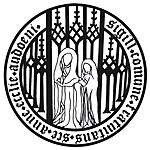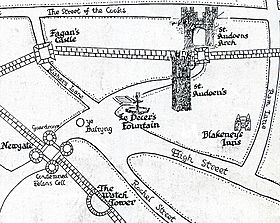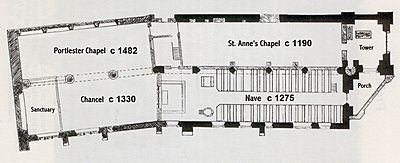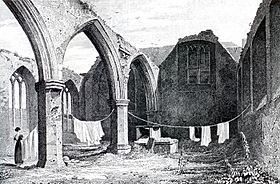St. Audoen's Church, Dublin (Church of Ireland) facts for kids
Quick facts for kids St Audoen's Church |
|
|---|---|
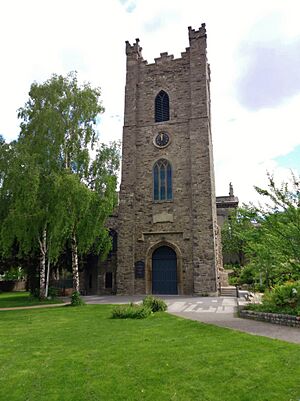 |
|
| Lua error in Module:Location_map at line 420: attempt to index field 'wikibase' (a nil value). | |
| Location | Cornmarket/High Street, Dublin |
| Country | Ireland |
| Denomination | Church of Ireland |
| Website | http://www.cathedralgroupdublin.ie/ |
| History | |
| Founded | 1190 |
| Founder(s) | John Comyn |
| Dedication | Audoen (bishop) |
| Administration | |
| Parish | St Catherine and St James with St Audoen |
| Diocese | Diocese of Dublin and Glendalough |
| Province | Province of Dublin (Church of Ireland) |
St Audoen's Church (/ˈɔːdən/, Irish: Eaglais San Audoen) is a historic Church of Ireland church in Dublin, Ireland. It is located south of the River Liffey, near the center of the old medieval city. St Audoen's is the oldest parish church in Dublin that is still in use today. A separate Roman Catholic church with the same name is located right next to it.
Contents
History of the Church
The church is named after St Ouen (also called Audoen), a French saint from the 7th century. It was built in 1190 by the Anglo-Normans after they came to Dublin. The church might have been built on the site of an even older church dedicated to St. Columcille.
Over the years, the church was changed and expanded. The main part of the church, called the nave, was made longer. About a hundred years later, a new section called a chancel was added at the end.
Guilds and Chapels
In the Middle Ages, many workers in Dublin belonged to guilds. A guild was like a club for people with the same job, such as bakers or tanners. These guilds were very important to the city and to St Audoen's Church.
In 1430, a special chapel called a chantry was built inside the church. It was dedicated to St Anne and was run by a group called the Guild of St Anne, which was mostly made up of bakers. This chapel had six different altars, paid for by wealthy families in the parish.
In 1485, a nobleman named Sir Roland Fitz-Eustace built another chapel. He did this to show his thanks for surviving a shipwreck.
Hard Times and Repairs
By the 1600s, the church was in bad shape. The Archbishop of Dublin complained that St Anne's Guild was keeping money that should have been used to fix the church. Over the next few years, people worked hard to repair the roof, steeple, and pillars.
Money was always a problem. In 1673, an order was given to remove the tombs from inside the church. This was a health precaution to "preserve the living from being injured by the dead."
By the 1800s, the church building was in ruins. There wasn't enough money for major repairs, so some parts of the church were closed or had their roofs removed. This caused many of the old tombs and memorials to crumble and be destroyed by the weather.
The Parish of St Audoen's
A parish is a local church community. For hundreds of years, St Audoen's parish was the richest in Dublin. The Lord Mayor and other important city officials often attended special events at the church. The Tanners' Guild had its meeting place in the church tower, and the Bakers' Guild was in a building next to the church.
The Reformation Changes Everything
In the 1500s, a major change called the English Reformation happened. King Henry VIII of England created a new church, which became known in Ireland as the Church of Ireland. St Audoen's became part of this new church.
However, most of the people in the parish remained Roman Catholic. They were no longer allowed to worship in St Audoen's Church. For many years, they had to hold their services in secret. This difficult time for Catholics lasted until the 1800s.
Meanwhile, the Church of Ireland parish of St Audoen's began to struggle. Over time, many wealthy families moved out of the city center. Poorer families moved into the old houses, and the parish became less wealthy.
Restoring a Historic Treasure
In 1866, an architect named Thomas Drew pointed out how important St Audoen's was. He created detailed plans of the building and helped people understand its history.
Major restoration work finally began in the 1980s. The tower and the church bells were repaired. A few years later, St Anne's chapel, which had no roof, was rebuilt. It is now a visitor center with an exhibit about the church's history.
In 1996, archaeologists dug up a small part of the church. Their discoveries helped everyone learn more about how the church was built and changed over the centuries.
Famous Tombs and Features
Inside the church, you can see many interesting historical items and memorials for important people.
The Lucky Stone
In the main porch, there is an ancient Celtic gravestone called the "Lucky Stone." It has been in this area since at least 1309. In the past, merchants and traders would rub the stone for good luck. It was stolen several times but was always found and returned.
Tombs and Memorials
The church holds the tombs of Sir Roland Fitz-Eustace and his wife Margaret. He was a very powerful nobleman in the 1400s.
Many other notable people are buried in the church, including:
- William Molyneux, a famous scientist and writer.
- His brother, Sir Thomas Molyneux, who was a doctor.
- Edward Parry, a bishop, and his two sons, who also became bishops.
An ancient stone font from the 12th century, used for baptisms, was found during digging in the 1800s. It is now on display in the church.
The Church Tower and Bells
The church tower was built in the 17th century and has often needed repairs. In 1669, part of it collapsed and had to be rebuilt. It was finally made safe during a major restoration in 1982.
The tower has six bells. Three of them are the oldest bells in Ireland, made in 1423! For about 85 years, the bells were silent because the tower was too fragile. After the tower was strengthened, the bells were repaired and can now be heard ringing every week.
The clock on the tower came from another Dublin church, St. Peter's, which was torn down in the 1980s.
The Old Graveyard
The old graveyard next to St Audoen's is no longer used for burials. It has been turned into a park for the community to enjoy. Many famous Dublin families and city mayors were buried here over the centuries.
Some of the people buried in the church or graveyard include:
- Margaret Ball, a former Mayor of Dublin who became a Catholic martyr.
- Bartholomew Ball and Nicholas Ball, her husband and son, who were also mayors.
- Lady Letitia Molesworth, a well-known society figure.
- Sir James Somerville, 1st Baronet
Famous Events at the Church
- In 1597, a huge gunpowder explosion on a nearby dock damaged the church tower.
- In the 1780s, James Napper Tandy, a famous Irish revolutionary, was a churchwarden at St Audoen's. He was baptized in the church in 1739.
- Another famous revolutionary, Oliver Bond, also served as a churchwarden.
The Church Organ
St Audoen's has a beautiful pipe organ built in 1885. It was restored in 2004. The organ still has its original manual bellows, which means it can be played without electricity.
| Great | Choir | Pedal |
|---|---|---|
| 8' Open Diapason | 8' Gamba | 16' Bourdon |
| 8' Stopped Diapason | 4' Waldflote | |
| 4' Principal | ||
| 2' Fifteenth | ||
| 8' Oboe | ||
| Ch to Ped | ||
| Ch to Gt | Gt to Ped |
See also
 In Spanish: Iglesia de St. Audoen, Dublin (Iglesia de Irlanda) para niños
In Spanish: Iglesia de St. Audoen, Dublin (Iglesia de Irlanda) para niños
- Guilds of the City of Dublin


